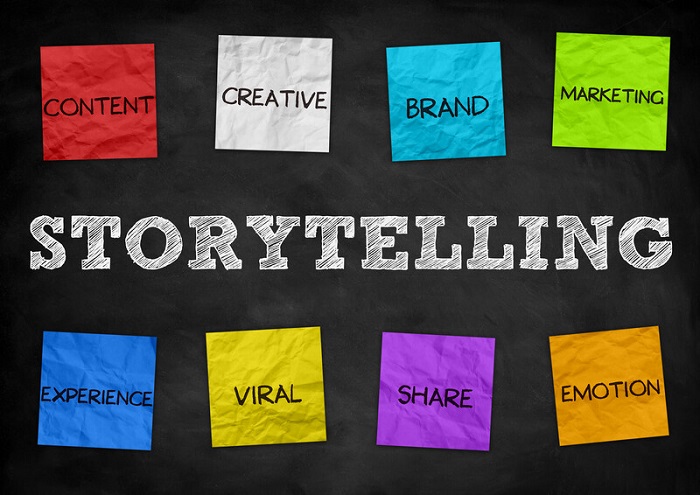Using Storytelling in Digital Marketing
All too often as marketers or business owners, we stumble by with an ordinary understanding of effective business or marketing.
For a moment, we should step away from our conceptions and try something more creative, more risky and innovative. One of those options might be the use of storytelling. Some marketers use storytelling excessively but it’s not something that is used in isolation.
Stories do make impact, but only when the right context is set for the story to be delivered.
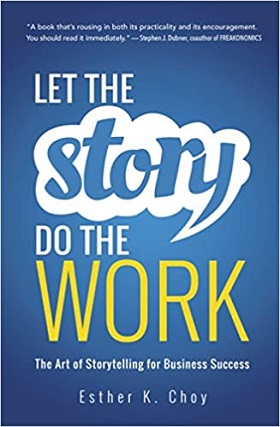 This post is about storytelling for marketing, and some as just mentioned, may conclude that it is “advanced marketing.” As Esther Choy in her book suggests, stories can do the work of your marketing, and take you onto a higher road to sales.
This post is about storytelling for marketing, and some as just mentioned, may conclude that it is “advanced marketing.” As Esther Choy in her book suggests, stories can do the work of your marketing, and take you onto a higher road to sales.
When you find the perfect hook, structure your story according to its strengths, and deliver it at the right time in the right way, you’ll see firsthand how easy it is to turn everyday communications into opportunities to connect, gain buy-in, and build lasting relationships. — Esther Choy in Let the Story do the Work.
Storytelling has been the forte of the motion picture industry for 120 years. Consumers forked out huge money to experience visual storytelling on the big screen. Some very bright marketers and advertisers have been using story techniques, but more marketers are sensing too that storytelling can generate a good impact. Is it possible to be effective in sales without stories? Most sales pros do tend to tell tales of all kinds to build the prospects intent.
And we might characterize storytelling as a softer form of marketing (e.g., social media posts). The subtlety, finesse, and emotional lift of stories have some powerful effects that you might want within your content strategy.
Of course, you yourself may have stories incorporated into your website about us page. It’s part of building a magnetic brand. That’s a good start but storytellers would say that your stories need some improvement. In this post we’ll venture into this interesting topic.
What is StoryTelling in Marketing?
Storytelling is communications that speak through people’s actions, personalities and real situations. It is the people’s words, actions and situation that conveys pain points and the right solutions. The storyline communicates the value of a product/service without citing bullet points and prices, and it suggests the path to satisfaction. Stories build empathy and immersion and can power up memory of specific produce/service benefits. In the end, storytelling serves your end goal better.
Storytelling then is a wholly new way for digital marketers to get its points across in ways the customer likes. Obviously speaking in pictures is an entirely different language and would require advanced thinking and strategy to achieve success. The story has to elicit the right emotions and conclusions.
And if the story succeeds, it will generate powerful emotions. Powerful emotions mean you only need to direct the customer to buy. The story does all the hard work of overcoming resistance, creating trust and credibility, and opening their wallet. And customer success stories are the go to narratives in modern times.
Feature/Benefits Marketing Not All that Interesting Anymore?
Marketing today is highly manipulative and consumers are exhausted and resentful. Whether storytelling is any less manipulative still has to be proven. And don’t stories have to be real?
From personal experience, I can tell you that my desire to travel for business is often for building experiences, ones that will help with marketing. It might be for any business owner. Those stories make us more relevant, interesting, and they generate more emotion in others. They create powerful connections that couldn’t be created through benefits and features marketing.
Quite a few companies are floundering simply because they lack these stories which deliver proof, credibility and fun. Without stories, marketing is a tough task.
Stories of customer’s pain and how your product/service resolved them provides relevance, significance and helps you match up to their intent to buy. Most stories involve customers, yet more advanced strategies might create story narratives that hard to comprehend. It might be some of the subtleties that captures the customers imagination.
Although I wasn’t an expert at the time, and didn’t know what I was doing, I at least knew that stories made me more compelling and relevant. They helped to create valuable new clients in interesting locales such as Boston, London, Florida, California and Western Canada. Since those stories created many $100,000 client, it worked well enough.
Storytelling might be worth building significant expertise in.
I’ll be happy to help you devise some excellent stories that after all will be essential to your advanced seo, advanced social media, and advanced content strategy.
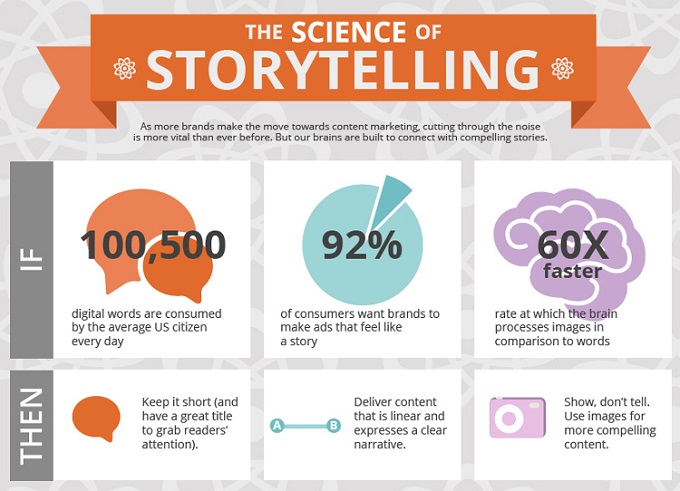
New Right-Brained Approaches to Marketing
The gist of the concept is to create narratives that get your brand and value proposition across in a non-technical way. It’s a right brained approach to building positive emotions, and since it bypasses the analytical, left side of the brain, it doesn’t generate emotional resistance. The left side after all is the gatekeeper.
I’m sure you know that when the customer gets analytical, and you’ve activated the left side of their brain’s critical functions, you’ve just ruined your sale. Left brain discussion activates fear, limitations, stopping points, resistance, friction, and non-creative views. The left pre-kills ideas with pre-conceived standards. This is why many left brained marketers never progress. Left brain thinking kills creative solutions and results in price cuts, mediocre offers, and eliminates market leader strategy.
If you’re having trouble selling your product/service, it may because you don’t have the wonderful stories that customer want to hear. You’re giving them great features and benefits, but that’s not what they want to hear. They want to hear something that makes them feel good, joyous and bubbly about your product. They want to be your cheerleader. Stories might set all that up.
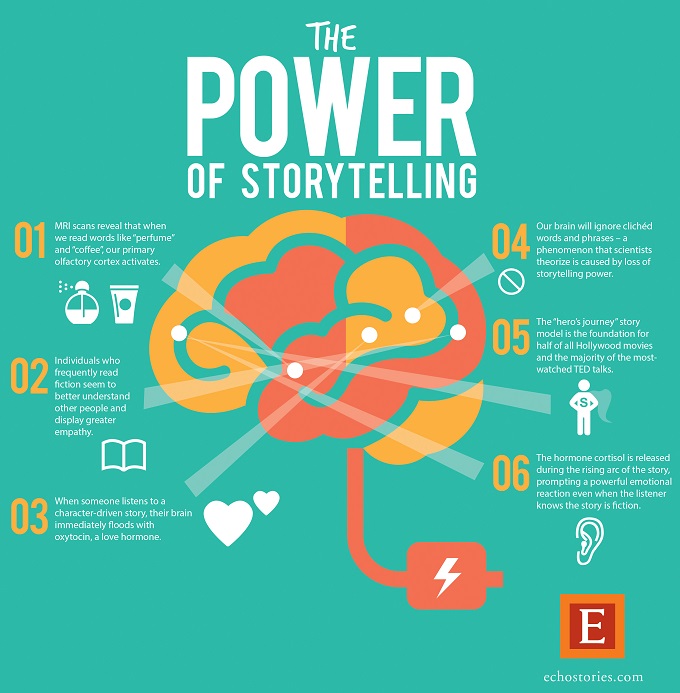
Benefits of Storytelling Marketing
- message is presented in a more fun, colorful and engaging manner — customer sees themselves using the product
- message is less detailed and confusing which keeps the left brain deactivated
- customer can’t resist as easily because doubts are hard to quantify and dispute
- factors that are typically problematic with normal digital marketing are not used
- your marketing doesn’t sound like a sales pitch
- your story integrates your company, people and products in a non-threatening way
- you activate your audience’s imagination so they can visualize using your product and moving toward total fulfillment
- you do more of the work of communicating value rather than forcing the customer to understand why your product/service is significant to them
- you create an experience that people can share and enjoy together (proof, relevance)
- you increase significance for the customer’s real life (significance, impact, memory)
- stories are more memorable and make the customer feel good
Yes, if making customer’s feel good is how you make your UVP significant, then stories can beat a list of benefits. One thing about weak stories though, is they don’t work and may build distrust. You could be right back where you started with an even more suspicious prospect.
Components of a Great Story
Here’s an interesting explanation of the flow of a story by Anna Vital of Adioma. Take a look.
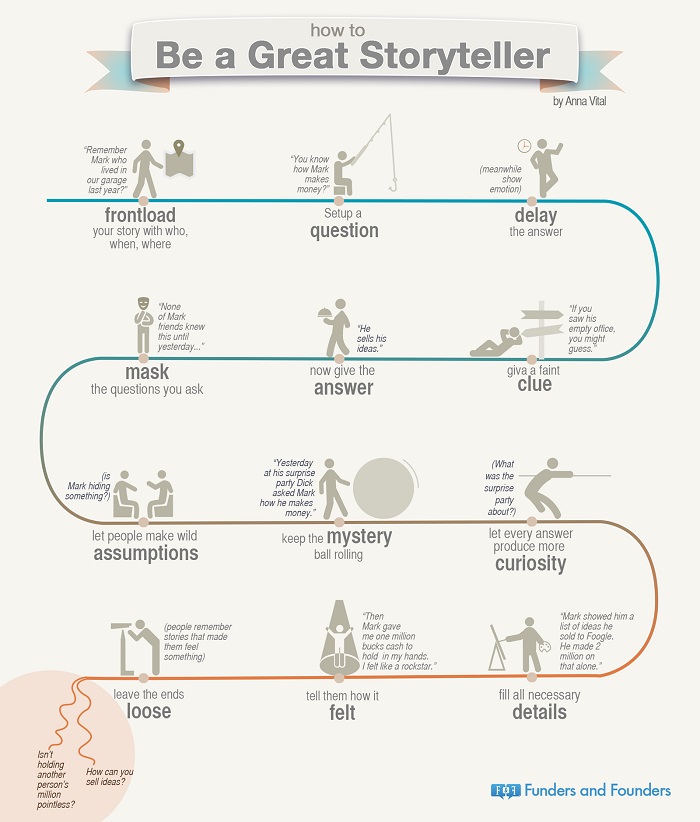
If you don’t have stories of your own, that’s okay. Ask colleagues for their stories of clients and competitors. Use those recollections to build a relevant version for your use.
And I’m sure, soon enough through experience, you will have great stories to tell. And remember, the story is really not about you, it’s about your customer and what they want to experience.
- what kind of story will it be: funny, serious, controversial? Which will your audience have the patience to hear?
- what is the point of the story? what key point is it making?
- what’s the hook that draws them in? what is the situation in it they care about and fear loss?
- the first task is to use a flow chart to brainstorm good ideas. Start with your product/service in the middle and draw arrows out for each major product benefit you need to convey. Consider the emotions they need to feel as benefits too. Those emotions drive the decision. For each benefit arrow, add in related features and envision a happening that corelates to the benefit
- create a conflict/pain point to resolve even if you don’t state it in the story
- create the beginning, middle and end and will flow to keep the customer engaged and entertained
- list some interesting and relevant characters for the story and give them interesting traits
- what is the ending and how do you think the reader/viewer will feel?
- what images should be in the story to make it relevant and impactful?
There are so many possibilities for story ideas and narratives applied to endless business sectors. It’s something only you can work through for yourself.
SEO Services | SEO Company | Hotel SEO | Advanced SEO Strategy | SEO Software | SEO Expert | Calgary SEO Service | SEO Agency San Diego | Advanced Link Building Company | Advanced SEO Consultant | Linkedin SEO

